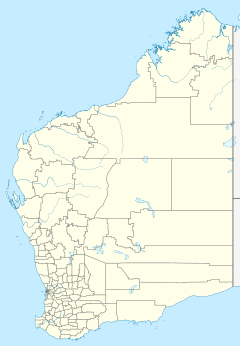Wooleen Station facts for kids
Wooleen Station is a huge farm in Western Australia. It used to raise sheep but now raises cattle. The station started in 1886. It is located in the Murchison area. The Murchison River flows right through it. Wooleen Station is about 680 kilometers (423 miles) north of Perth. It is part of the Shire of Murchison.
Wooleen Station is next to Boolardy Station. Boolardy is now home to the Murchison Radio-astronomy Observatory. This observatory includes the Square Kilometre Array (SKA). The SKA is a massive telescope project.
Contents
The Story of Wooleen Station
How Wooleen Station Began
Wooleen Station was first claimed in 1887. By 1890, James Sharpe and David McWhinney owned it. In February 1890, the station faced a big problem. About 1,100 sheep and their shepherd died. This happened because of extreme heat and a lack of water. The shepherd, named Templeton, was found with a note. It described how he was in trouble. Luckily, good rains fell a few days later.
Changes and Growth Over Time
In 1921, heavy rains caused floods in the area. The local mail was stuck at Wooleen for a while. Nearby farms reported up to 15 inches (38 cm) of rain. A large shearing shed was built in 1922. This shed had 12 stands for shearing sheep.
Ben Sharpe, who owned Wooleen Station, also leased Mardie Station in 1923. In 1924, Sharpe got a new vehicle for the station. It was a 15-horsepower Crossley car. It had a tray body for carrying things around the farm. In 1924, over 28,000 sheep were shorn at Wooleen Station.
By 1954, the property was very large. It covered about 460,000 acres (186,000 hectares). It was home to 30,000 sheep.
The Sharpe Family and New Owners
The Sharpe family later bought the lease back. They ran the station until 1984. Christopher Sharpe was the last male family member to own it. He passed away in 1984. His uncle, David Sharpe, and aunt, Sheila Sharpe (also known as Peg), ran the station from 1944 to 1956. Sheila was the sister of a famous mining person, Lang Hancock.
In 1990, the Pollock family took over Wooleen. Helen and Brett Pollock decided to change things. They shifted the focus from raising animals to a farm-stay business. This helped the station financially. They welcomed their first guests in 1993. Their son, David, and his partner, Frances Jones, took over in 2007.
David and Frances have worked to make the property more sustainable. They want to protect the environment. Their story was even shown on the TV show Australian Story in 2012. The episode was called "Saving Wooleen."
The Wooleen Homestead
The main house at Wooleen Station is called the homestead. It is a very old and special building. It is about 1,200 square meters (12,900 square feet) in size. It has wide verandahs, which are like covered porches. Inside, there is a large billiards room and a big library. The homestead even has its own swimming pool.
What is Wooleen Station Like Today?
Wooleen Station covers a huge area. It is about 152,000 hectares (375,600 acres). Most of the land is covered in mulga scrub. Mulga is a type of tree. The property also includes 36 kilometers (22 miles) of the Murchison and Roderick Rivers. Lake Wooleen is also on the property.
Wooleen Station is bordered by other large properties. To the north is Meeberrie. To the east is Boolardy. To the south is Murgoo Station.
As of 2020, the owners are looking for ways to grow tourism. They want more people to visit the station. This is because it is close to Boolardy Station. Boolardy is where the Murchison Radio-astronomy Observatory is located. This observatory includes the Square Kilometre Array.


